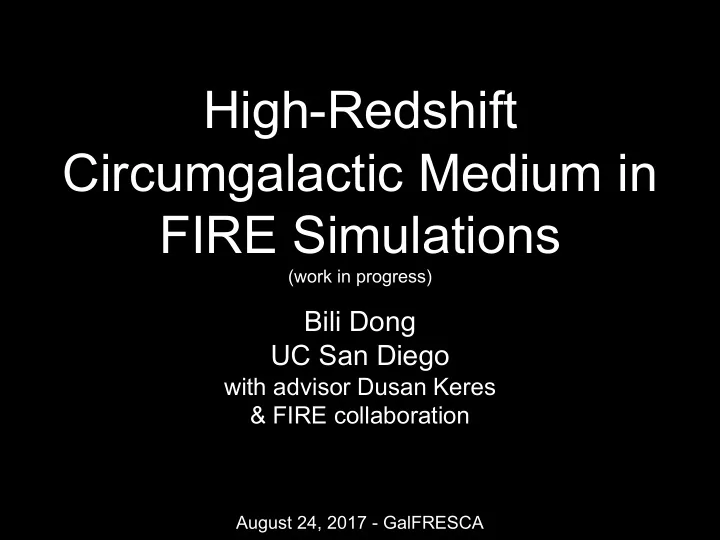

High-Redshift Circumgalactic Medium in FIRE Simulations (work in progress) Bili Dong UC San Diego with advisor Dusan Keres & FIRE collaboration August 24, 2017 - GalFRESCA
Circumgalactic Medium (CGM) background source down the barrel transverse absorption-line Empirical definition: gas surrounding galaxies within virial radii
CGM Distribution from Observations increasing ionization potential increasing ionization potential
COS-Burst Lya SiIII CIV OVI Heckman et al. 2017 ● 17 low-redshift starburst galaxies vs control sample ● Starbursts could influence CGM distribution and kinematics
Cosmic Star-Formation History ● SFR peaks at 1 < z < 3 (cosmic noon)
http://fire.northwestern.edu/ FIRE-2, Hopkins et al. 2017 FIRE-1, Hopkins et al. 2014 ● Images are logarithmically-weighted surface-density projections, showing hot (> 10 6 K), warm ionized (~ 10 4 - 10 5 K), and cool neutral (< 8000K) gas
Galactic Winds in FIRE outflow outflow SFR×10 inflow outflow inflow Muratov et al. 2015 ● High-redshift galaxies undergo bursty star formation followed by high mass-loading outflows suppressing inflows and SFR ● How do inflow & outflow shape CGM?
Halo Sample snapshots at z = 2 MFz2_A1 z2h506 ● FIRE-1 feedback log M = 12.38 log M = 12.08 ● Halo mass range: 11.7 - 12.4 z2h400 z2h830 ● Redshift range: 2 - 4 log M = 11.90 log M = 11.73
Radial-Temporal Profiles ● Ion fields added using Trident (Hummels et al. 2016) ● Correlation between CGM distribution and inflow/outflow
Keck Baryonic Structure Survey (KBSS) Rudie et al. 2012 Steidel et al. 2014 Turner et al. 2014 ● EW converted to N assuming linear curve-of-growth regime
Simulation vs Observation decreasing halo mass ● Averaged over 2 < z < 3 ● Is there a halo mass trend?
Bonus: the Demeshening in yt A work by Nathan Goldbaum, Meagan Lang and Matthew Turk to remove the global octree mesh for particle data particle method octree method Goldbaum & Lang, SciPy 2017 https://doi.org/10.6084/m9.figshare.5203801.v1 ● Does octree method converge to particle method?
Octree vs Particle converge
Octree vs Particle Can we describe this distribution analytically? converge
Summary ● Preliminary results ○ Correlation between CGM distribution and inflow/outflow ○ CGM distribution in FIRE matches high-redshift observation ○ Potential halo mass trend in CGM distribution ● Numerical tests on yt demeshening ○ Octree method converges to particle method ● Future work ○ Physical explanation (phase structure? metallicity?) ○ Upgrade to FIRE-2 for better numerics and physics ○ Larger sample for better statistics ○ Mock spectra for fairer comparisons with observations (using Trident) Thank you! Bili Dong
Recommend
More recommend